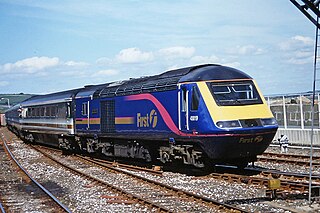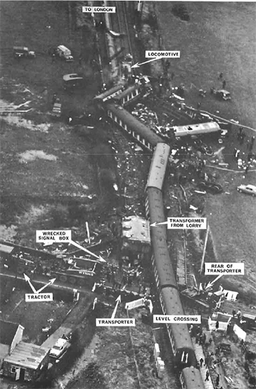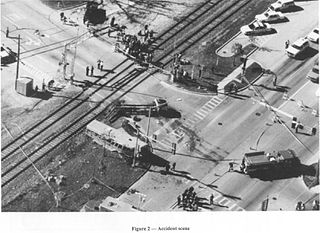
A level crossing is an intersection where a railway line crosses a road, path, or airport runway, at the same level, as opposed to the railway line crossing over or under using an overpass or tunnel. The term also applies when a light rail line with separate right-of-way or reserved track crosses a road in the same fashion. Other names include railway level crossing, railway crossing, grade crossing or railroad crossing, road through railroad, criss-cross, train crossing, and RXR (abbreviated).

The Ufton Nervet rail crash occurred on 6 November 2004 when a passenger train collided with a stationary car on a level crossing on the Reading–Taunton line near Ufton Nervet, Berkshire, England. The collision derailed the train, and seven people—including the drivers of the train and the car—were killed. An inquest found that all railway personnel and systems were operating correctly, and the crash was caused by the suicide of the car driver.
The Cowan rail accident occurred at 7:20pm on 6 May 1990 when the 3801 Limited special steam passenger train returning from the Morpeth Jazz Festival was struck in the rear by the following CityRail inter-urban passenger service. The steam train had stalled while attempting to climb the steep gradient from the Hawkesbury River to Cowan, New South Wales, and it was found that sand applied to the rails to regain traction had interfered with the signals and given the following train a false clear indication.

On 6 January 1968, a low-loader transporter carrying a 120-ton electrical transformer was struck by a British Rail express train on a recently installed automatic level crossing at Hixon, Staffordshire, England.

Gerogery is a town established on Wiradjuri land in the Murray region of the Australian state of New South Wales. The town is in the Greater Hume Shire local government area and on the Main South railway line between Sydney and Melbourne, where it intersects with the Olympic Highway. Gerogery serves a rural farming community. Gerogery has a temperate climate. It lies close to the Great Yambla Range, with its striking Tabletop and Sugar Loaf ridge at the southern end.
The Grafton bus crash killed 21 people and injured 22 on the Pacific Highway near Grafton, Australia on 20 October 1989 when a semi-trailer truck collided with a Sunliner Express coach operating an express service from Sydney to Brisbane. At the time, it was the worst in Australian road transport history in terms of number of deaths. Two months later it was surpassed by the Kempsey bus crash that killed 35 passengers.

The 1995 Fox River Grove bus–train collision was a grade crossing collision that killed seven students riding aboard a school bus in Fox River Grove, Illinois, on the morning of October 25, 1995. The school bus, driven by a substitute driver, was stopped at a traffic light with the rearmost portion extending onto a portion of the railroad tracks when it was struck by a Metra Union Pacific Northwest Line train, train 624 en route to Chicago.

In Lockington, England on 26 July 1986, the 09:33 passenger train from Bridlington to Kingston upon Hull on the Hull to Scarborough Line struck a passenger van on a level crossing.
The Murulla rail accident involved the collision of the Sydney-bound Northern Mail with runaway goods wagons near Murrurundi, in the Upper Hunter Valley on 13 September 1926; 26 persons died. A goods train had become divided and the attempts of the train crew to reunite the portions resulted in 12 vehicles running away down a steep gradient, and colliding with the approaching mail train. This was the worst accident on the New South Wales rail network until the Granville railway disaster in 1977.
There have been a number of train accidents on the railway network of Victoria, Australia. Some of these are listed below.
The railways of New South Wales, Australia have had many incidents and accidents since their formation in 1831. There are close to 1000 names associated with rail-related deaths in NSW on the walls of the Australian Railway Monument in Werris Creek. Those killed were all employees of various NSW railways. The details below include deaths of employees and the general public.

The Kerang train accident occurred on 5 June 2007 at about 13:40 AEST in the Australian state of Victoria, approximately 6 kilometres (3.7 mi) north of the town of Kerang in the state's northwest, and 257 kilometres (160 mi) north-northwest of the city of Melbourne.

Culcairn railway station is a heritage-listed railway station located on the Main Southern line in New South Wales, Australia. It serves the town of Culcairn. It was added to the New South Wales State Heritage Register on 2 April 1999.

The Little Cornard derailment occurred on 17 August 2010 when a passenger train collided with a road vehicle on a level crossing on the Gainsborough Line near Little Cornard, Suffolk, and partly derailed. The vehicle, a tanker lorry, had begun crossing over the track when the Class 156 train from Sudbury destined for Marks Tey struck it whilst travelling at a speed of approximately 40 miles per hour (64 km/h).
This article lists significant fatal, injury-only, and other accidents involving railway rolling stock, including crashes, fires and other incidents in the Australian state of South Australia. The first known incident in this list occurred in 1873 in Smithfield.
This article is concerned with railway accidents occurring in Western Australia, where they are identified as fatal accidents, injury related accidents, or where infrastructure or rolling stock was damaged.
John Birley Abernethy is a former State Coroner of New South Wales.

The Ottawa bus–train crash was a collision that occurred between an OC Transpo double-decker bus and a Via Rail train in the Ottawa suburb of Barrhaven on September 18, 2013, that killed six people.

There are around 6,000 level crossings in the United Kingdom, of which about 1,500 are public highway crossings. This number is gradually being reduced as the risk of accidents at level crossings is considered high. The director of the UK Railway Inspectorate commented in 2004 that "the use of level crossings contributes the greatest potential for catastrophic risk on the railways." The creation of new level crossings on the national network is banned, with bridges and tunnels being the more favoured options. The cost of making significant reductions, other than by simply closing the crossings, is substantial; some commentators argue that the money could be better spent. Some 5,000 crossings are user-worked crossings or footpaths with very low usage. The removal of crossings can improve train performance and lower accident rates, as some crossings have low rail speed limits enforced on them to protect road users. In fact, between 1845 and 1933, there was a 4 miles per hour (6.4 km/h) speed limit on level crossings of turnpike roads adjacent to stations for lines whose authorising act of Parliament had been consolidated in the Railways Clauses Consolidation Act 1845 although this limit was at least sometimes disregarded.
The Salt Clay Creek railway disaster was one of Australia's first railway accidents involving multiple fatalities. It occurred on the evening of 25 January 1885, when a mail train from Albury to Sydney failed to negotiate a flooded creek, around 5 km from Cootamundra. Seven people were killed and dozens seriously injured.










